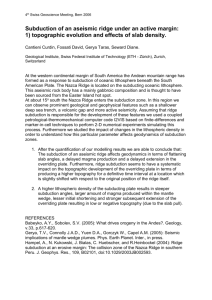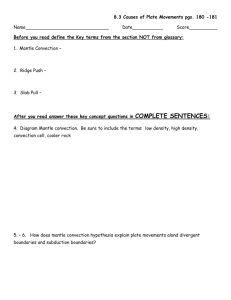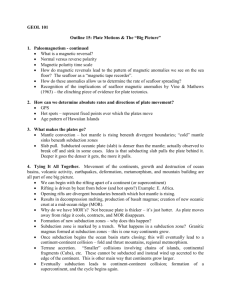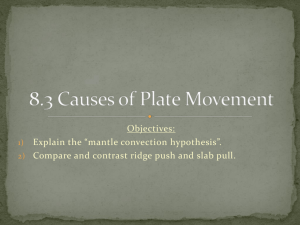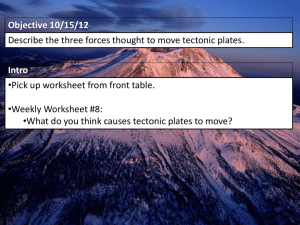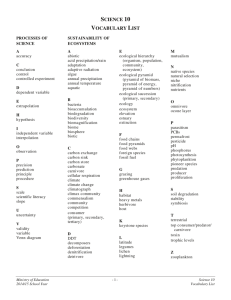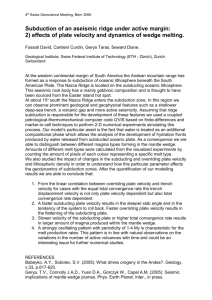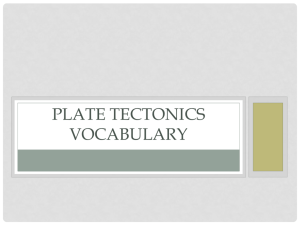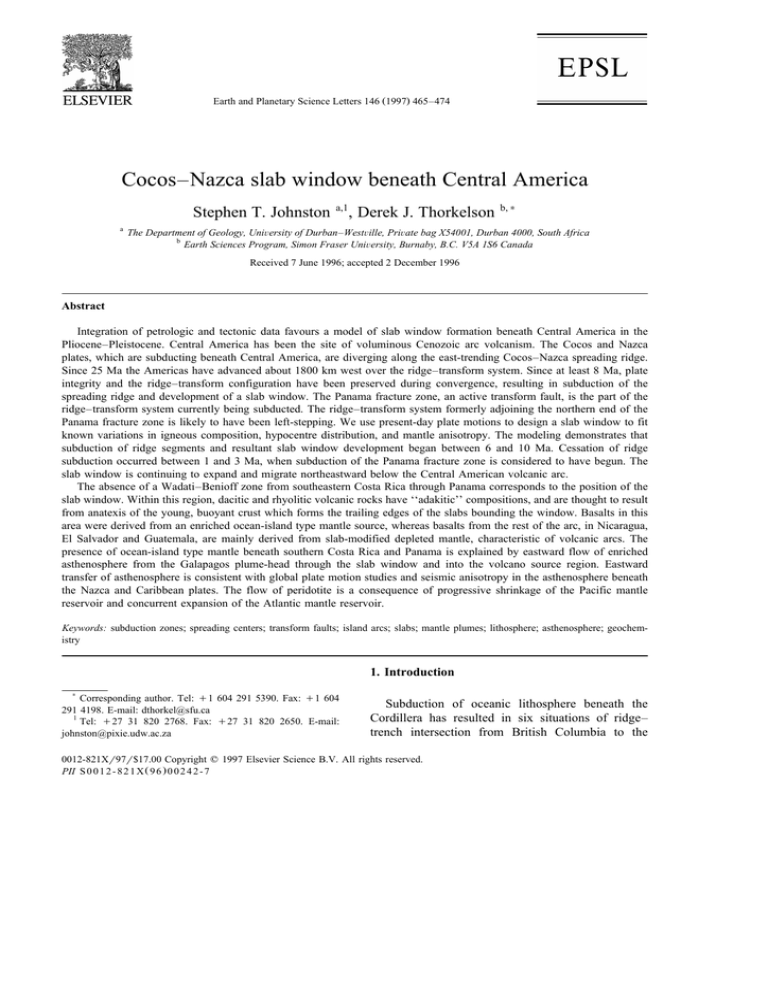
Earth and Planetary Science Letters 146 Ž1997. 465–474
Cocos–Nazca slab window beneath Central America
Stephen T. Johnston
a
a,1
, Derek J. Thorkelson
b,)
The Department of Geology, UniÕersity of Durban–WestÕille, PriÕate bag X54001, Durban 4000, South Africa
b
Earth Sciences Program, Simon Fraser UniÕersity, Burnaby, B.C. V5A 1S6 Canada
Received 7 June 1996; accepted 2 December 1996
Abstract
Integration of petrologic and tectonic data favours a model of slab window formation beneath Central America in the
Pliocene–Pleistocene. Central America has been the site of voluminous Cenozoic arc volcanism. The Cocos and Nazca
plates, which are subducting beneath Central America, are diverging along the east-trending Cocos–Nazca spreading ridge.
Since 25 Ma the Americas have advanced about 1800 km west over the ridge–transform system. Since at least 8 Ma, plate
integrity and the ridge–transform configuration have been preserved during convergence, resulting in subduction of the
spreading ridge and development of a slab window. The Panama fracture zone, an active transform fault, is the part of the
ridge–transform system currently being subducted. The ridge–transform system formerly adjoining the northern end of the
Panama fracture zone is likely to have been left-stepping. We use present-day plate motions to design a slab window to fit
known variations in igneous composition, hypocentre distribution, and mantle anisotropy. The modeling demonstrates that
subduction of ridge segments and resultant slab window development began between 6 and 10 Ma. Cessation of ridge
subduction occurred between 1 and 3 Ma, when subduction of the Panama fracture zone is considered to have begun. The
slab window is continuing to expand and migrate northeastward below the Central American volcanic arc.
The absence of a Wadati–Benioff zone from southeastern Costa Rica through Panama corresponds to the position of the
slab window. Within this region, dacitic and rhyolitic volcanic rocks have ‘‘adakitic’’ compositions, and are thought to result
from anatexis of the young, buoyant crust which forms the trailing edges of the slabs bounding the window. Basalts in this
area were derived from an enriched ocean-island type mantle source, whereas basalts from the rest of the arc, in Nicaragua,
El Salvador and Guatemala, are mainly derived from slab-modified depleted mantle, characteristic of volcanic arcs. The
presence of ocean-island type mantle beneath southern Costa Rica and Panama is explained by eastward flow of enriched
asthenosphere from the Galapagos plume-head through the slab window and into the volcano source region. Eastward
transfer of asthenosphere is consistent with global plate motion studies and seismic anisotropy in the asthenosphere beneath
the Nazca and Caribbean plates. The flow of peridotite is a consequence of progressive shrinkage of the Pacific mantle
reservoir and concurrent expansion of the Atlantic mantle reservoir.
Keywords: subduction zones; spreading centers; transform faults; island arcs; slabs; mantle plumes; lithosphere; asthenosphere; geochemistry
1. Introduction
)
Corresponding author. Tel: q1 604 291 5390. Fax: q1 604
291 4198. E-mail: dthorkel@sfu.ca
1
Tel: q27 31 820 2768. Fax: q27 31 820 2650. E-mail:
johnston@pixie.udw.ac.za
Subduction of oceanic lithosphere beneath the
Cordillera has resulted in six situations of ridge–
trench intersection from British Columbia to the
0012-821Xr97r$17.00 Copyright q 1997 Elsevier Science B.V. All rights reserved.
PII S 0 0 1 2 - 8 2 1 X Ž 9 6 . 0 0 2 4 2 - 7
466
S.T. Johnston, D.J. Thorkelsonr Earth and Planetary Science Letters 146 (1997) 465–474
Antarctic Peninsula since the Late Cretaceous w1–4x.
All of these intersections are known to correlate with
magmatic, and in some cases tectonic, anomalies in
the overriding plate. In four of the five cases, these
anomalies have been explained with models of slab
window development. In the remaining case, where
the Cocos–Nazca plate boundary intersects the Middle American trench, the anomalous magmatic and
tectonic features have not been placed in a slab
window context. Importantly, a convincing physical
explanation for the pronounced along-arc geochemical trends in the Central American arc w5–7x has yet
to be established. This paper provides a model of
slab window formation beneath Central America,
demonstrates how window development can explain
the magmatic and tectonic anomalies, and speculates
on the nature of lithosphere–asthenosphere interactions in the Cocos–Nazca–Caribbean plate region.
A slab window is a slab-free region beneath the
convergent margin of an overriding plate w1–4,8x.
The window develops during ‘‘ridge subduction’’, in
which two oceanic plates are diverging, and the
trailing edge of one or both plates is concurrently
subducting. Prior to subduction, the divergent boundary is the site of sea-floor spreading, where the plates
grow as rising magma cools and accretes onto their
trailing edges. At a ridge–trench encounter, one or
both of the trailing plate edges descend into the
asthenosphere. Once engulfed by asthenosphere, a
trailing edge becomes too hot to serve as a site of
magma solidification, and growth of the slab ceases.
Divergence without growth produces a slab window.
First-order estimates of window shape can be made
from plate kinematic data. Modeling of thermal conditions w9,10x and strain w11,12x in the slabs is required for more comprehensive depictions.
Ridge–trench intersections produce systematic
changes in the overriding plate, as expressed by the
previously recognized Cordilleran slab windows below British Columbia and Alaska w2,13,14x, the
southwestern United States w1x, southern Chile w3x,
and the Antarctic Peninsula w4x. Above a slab window, volcanism of arc character ceases and may be
replaced by eruptions of alkalic to tholeiitic magmas
with intraplate affinity w3,15,16x. Forearc volcanism
may become locally abundant w13,14,17,18x. Above
the margins of a slab window, volcanoes may erupt
geochemically unusual dacites, termed adakites or
bajaites, regarded as possible anatectic melts of young
subducted slab w19–21x. In some cases, high heat
flow, uplift and extension accompanies the magmatic
effects w1,2,22x.
2. Postulated Central American slab window
2.1. Prediction of a slab window from regional plate
interactions
Five plates, the North American, Caribbean, South
American, Cocos, and Nazca plates, interact in the
Central American region ŽFig. 1.. The Caribbean
plate separates the North and South American plates
and extends from the sinistral Motagua–Cayman
Trough fault zone south to a diffuse boundary between the South Caribbean deformed zone and the
Bocono–East Andean fault zone in the northern Andes w23–25x. Along the Middle America trench, the
oceanic Cocos and Nazca plates are subducting eastward beneath the ‘‘American’’ plates, producing arc
volcanism from Mexico to Columbia w5,26x. Divergence between the Cocos and Nazca plates is accommodated by the east-trending Cocos–Nazca ridge–
transform system which became active at about 25
Ma w27x. The easternmost part of the Cocos–Nazca
plate boundary is the Panama fracture zone, a long,
active transform fault which intersects the Middle
America trench near the Costa RicarPanama border.
The Cocos ridge, an aseismic ridge on the Cocos
plate that formed from interaction between the Galapagos hot-spot and the Cocos–Nazca spreading ridge
w27x, intersects the trench at about the same point as
the fracture zone. Pliocene to recent subduction of
the Cocos ridge has locally deformed the forearc and
uplifted the volcanic arc in southern Costa Rica
w28,29x.
Present-day plate motion studies w30,31x indicate
that the Cocos plate is subducting rapidly northeastward beneath most of Central America ŽFig. 1..
Convergence rates for the Cocos plate range from
about 6 cmra along the coast of Mexico to nearly 10
cmra in southern Costa Rica. The Nazca plate is
converging eastward with northern South America at
about 7 cmra. The northernmost part of the Nazca
plate, which is subducting beneath Panama at a
highly oblique angle, may be separated from the
S.T. Johnston, D.J. Thorkelsonr Earth and Planetary Science Letters 146 (1997) 465–474
main part of the Nazca plate by a postulated but
unidentified transform or spreading boundary w31,32x.
Depending on the relative velocities along this postulated boundary, motion of the so-called ‘‘North
Nazca’’ plate relative to Panama may range from
about 3.5 to 6.5 cmra w31x.
Paleogeographic reconstructions imply that approximately 1800 km of the Cocos–Nazca spreading
ridge has been subducted since its inception at 25
Ma w27x. In detail, however, the orientation and
behavior of the missing ridge–transform boundary is
uncertain. Fossil spreading centres ranging in age
from 8 to 22 Ma are located in the North Nazca plate
region w7x, suggesting that the Cocos–Nazca plate
boundary previously extended into this area, and that
467
the near-ridge parts of these plates became fragmented as spreading centres stalled near the trench.
However, no fossil spreading centres younger than
about 8 Ma have been identified. These observations
imply that plate fragmentation related to ridge–trench
encounters was limited to the Miocene. Thus, from
the Pliocene to the present, subduction of the ridge–
transform boundary appears to have been uniform,
and uninterrupted by changes in the location or
orientation of spreading segments. The plate regime
of Central America thereby satisfies the two general
conditions necessary for the existence of a presentday slab window: Ž1. convergence of a spreading
ridge with a subduction zone for the past several Ma;
and Ž2. sufficient conservation of plate integrity dur-
Fig. 1. Simplified tectonic setting of Central America w5,7,42x showing surface projection of postulated slab window between Cocos and
Nazca plates beneath southeastern Costa Rica and northwestern Panama. Vectors on Cocos and Nazca plates indicate plate velocites in
centimetersryear with reference to fixed Caribbean or South American plates, based on Nuvel-1 plate motion model w30x. Slab window
geometry is based on subduction of a left-stepping ridge–transform boundary from 7 to 2 Ma, followed by subduction of the Panama
fracture zone ŽPFZ. from 2 Ma to the present. The position of the PFZ and postulated ridge–transform segments at 7 Ma are shown by a
dashed line to the west of the modern PFZ. Dip angles of the Nazca and Cocos slabs used in window construction are 08 and 258,
respectively. ' s Volcanoes. Inset map indicates relative plate motions in velocity space at the Caribbean–Cocos–Nazca triple junction.
Vector lengths correspond to motion during a 5 Ma interval. Shaded triangle is predicted shape of slab window surface projection under
conditions of subhorizontal subduction. Car s Caribbean; Coc s Cocos; Naz s Nazca; J s triple junction; R s Cocos–Nazca spreading
ridge.
468
S.T. Johnston, D.J. Thorkelsonr Earth and Planetary Science Letters 146 (1997) 465–474
ing ridge subduction for the subducted parts of the
slabs to diverge from one another.
Subduction of a spreading segment in the Pliocene
or Pleistocene seems likely from analysis of the
present plate situation. Currently, the Panama fracture zone is the part of the Cocos–Nazca plate
boundary which is being subducted. Although the
configuration of the plate boundary which lay north
of the Panama fracture zone is unconstrained, it is
likely that the northern end of the fault originally
connected with a spreading ridge, or a ridge–transform fault boundary, which has since been subducted
ŽFig. 1.. As this northern spreading segment was
overridden by the Caribbean plate, a slab window
would have formed between the trailing edges of the
subducted Cocos and Nazca slabs. As subduction of
this spreading segment ended, and subduction of the
Panama fracture zone began, the slab window would
have ceased to form at the trench. With continued
subduction of the Panama fracture zone, the window
would have widened and moved northeastward.
2.2. EÕidence for a slab window
The absence of a Wadati–Benioff zone from
southeastern Costa Rica through Panama supports
the possibility of a slab window flanked by buoyant,
subhorizontal trailing plate edges ŽFig. 2.. Compilation of earthquake hypocentres beneath Central
America reveals that the Cocos plate shallows from
about 608 below Guatemala to less than 308 beneath
central Costa Rica w12x. Farther southeast, toward the
triple junction, the Cocos slab is not seismically
evident below about 70 km. Deep seismic reflection
studies west of southern Costa Rica indicate that the
Cocos slab is sliding at a low angle along the base of
the Caribbean plate forearc w29x. Southeast of the
Panama fracture zone, the absence of sublithospheric
hypocentres indicates that the Nazca plate is either
absent or subducting subhorizontally beneath Panama
w12x.
Previous interpretations of the seismic data have
focused on subduction of the Cocos ridge w5,7,29x,
which intersects the trench at about the same point as
the Panama fracture zone ŽFigs. 1 and 2.. Subduction
of the thick, relatively buoyant Cocos ridge can
explain a variety of phenomena, including shallow
subduction of the Cocos plate beneath Costa Rica
Fig. 2. Tectonic map of Central America showing postulated
geometry of subducted Cocos and Nazca slabs, and the slab
window, beneath the Caribbean plate. The shape of the slab
window to the south and east of central Panama Žolder than 7 Ma.
is unconstrained. Variation in the geochemical character of the
mantle underlying the volcanic arc is shown by progressive
shading of schematically located volcanoes. Dip angles are indicated for three locations on the Cocos plate. PFZs Panama
fracture zone.
and related uplift of forearc and arc. However, subduction of the Cocos ridge cannot explain either the
absence of seisimicity in the Nazca slab beneath
Panama, or the regional variations in arc geochemistry Ždiscussed below..
S.T. Johnston, D.J. Thorkelsonr Earth and Planetary Science Letters 146 (1997) 465–474
Geochemical information from Quaternary volcanoes infers that mantle characteristics beneath Central America vary profoundly from northwest to
southeast w5,7,6x ŽFig. 2.. In the northern part of the
Central American arc ŽGuatemala to Nicaragua., isotopic and geochemical parameters indicate magma
derivation mainly from slab-metasomatized, mid-ocean ridge basalt ŽMORB. –source mantle, typical of
most arcs. To the southeast, in Costa Rica and
Panama, basalts indicate derivation from ocean-island basalt ŽOIB.-type enriched mantle affected little
by subduction metasomatism w5,6x. The southward
increase in OIB character is evident from trends in
trace element concentrations and radiogenic isotope
ratios. The change from Nicaragua to Panama is
particularly well defined by BrLa, which decreases
from about 5 to about 0.1 w5x, and by 143 Ndr 144 Nd,
which decreases from about 0.5131 to 0.5129 w6x.
The transition from arc to OIB composition is so
pronounced that it has been described as a conundrum w5x.
Aluminum-rich, Y-poor dacites and rhyolites occur in the segment of the arc extending from southeastern Costa Rica through central Panama w7,20x.
Rocks of this type, termed adakite, have been interpreted as products of slab anatexis in this region and
in parts of convergent margins elsewhere w20,21x.
Thermal modeling indicates that melting of young
subducted crust is a viable process, and is most
likely where the subducting slab is youngest w9,10x.
The youngest and hottest lithosphere subducting beneath the Central American arc lies in the region of
the Cocos–Nazca spreading ridge, directly offshore
from the sites of adakite magmatism, thus supporting
the idea of slab anatexis.
The increase in OIB-like chemical characteristics
toward the triple junction infers that the mantle
wedge beneath the arc volcanoes has been progressively contaminated or displaced by mantle of enriched plume origin. Contamination is envisaged by
the flow of mantle from beneath Žand west. of the
slabs to above them. Under normal arc conditions,
the downgoing slab divides the asthenosphere into
sub- and supra-slab reservoirs, each with distinctive
geochemical and thermal attributes. Flow of mantle
from one reservoir to the other is blocked by the
descending plate. However, under conditions of ridge
subduction and subsequent slab window develop-
469
ment, the slab barrier is locally absent and the suband supra-slab reservoirs are brought into contact
w1,8x. Flow of mantle from one reservoir into the
other may occur according to pressure gradients
related to differences in mantle composition and
temperature, and motions of the subducting slabs
w33x.
The OIB characteristics are likely to have been
derived from sub-slab asthenosphere belonging to, or
affected by, the Galapagos plume head. The Galapagos plume has formed an axial to near-axial hot-spot
for at least the last 25 Ma w27x, and its plume head is
likely to extend under large areas of the Cocos and
Nazca plates. A Galapagos plume source is supported by similarities in chemical characteristics between the OIB-like parts of the arc and the Galapagos hot-spot track w5,27x. We contend that a slab
window between the Cocos and Nazca plates provides a plausible, suitably located pathway for voluminous influx of enriched sub-slab peridotite into the
arc source region. The locations of the adakitic
volcanic rocks in Panama and southeastern Costa
Rica, possibly generated by slab anatexis, are consistent with melting of the thin, young, trailing edges of
the subducted lithosphere bounding the slab window
ŽFigs. 2 and 3..
2.3. PreÕious explanations
Previous attempts to reconcile the geochemical
transitions in the arc have not considered the possibility of divergence between the subducted parts of
the Cocos and Nazca plates; that is, the formation of
a slab window. In one model w6x, the geochemical
trend is explained by transfer of ‘‘plum pudding’’
asthenosphere containing OIB-like peridotite from
beneath the Nazca plate to the mantle wedge beneath
southern Costa Rica and Panama. This model implied that ‘‘flattening and breakup of the subducting
plate below eastern Costa Rica and Panama’’ provided the mechanism for OIB-like asthenosphere
from beneath the Nazca plate reaching the arc source
region. The apparent contradiction of a deforming
slab in an area of seismic inactivity was not addressed. In another model w5x, the southerly increase
in OIB-type characteristics was explained by gentler
subduction angles, leading to shallower depths of
slab dehydration, and consequent melting of
470
S.T. Johnston, D.J. Thorkelsonr Earth and Planetary Science Letters 146 (1997) 465–474
Caribbean plate lithosphere, parts of which were
postulated to be enriched. The aseismic region beneath southern Costa Rica and Panama was rationalized in terms of the high heat flow and buoyancy of
the subducting oceanic lithosphere.
Although both of these models w5,6x appealed to
sources of enriched mantle, they differ considerably
from the interpretation presented here. In the first
model w6x, the sub-slab region was identified as the
source of enrichment, but the pathway for mantle
flow was a postulated break in the Cocos slab beneath northern Costa Rica. This explanation may not
be viable because, in a recent review of seismic data,
the suggestion of a tear in the Cocos slab was
rejected in favour of a sharp flexure w12x. Even if the
slab in this area is torn, the resultant pathway would
lie hundreds of kilometres too far to the northwest to
account for the OIB-like compositions in southeastern Costa Rica and Panama. In the second model w5x,
a sub-slab origin for the enriched mantle source was
not considered, and the slab barrier to mantle flow
was assumed to be intact. In contrast to these models
w5,6x, our interpretation explains the anomalous geochemical characteristics of the Central American arc
by: Ž1. considering the region in a tectonic framework of ridge-trench convergence; Ž2. fully accounting for the gap in slab seismicity; Ž3. demonstrating
the likelihood of a slab window with appropriate
location and age; and Ž4. appealing to a known
source of asthenospheric enrichment.
2.4. Mantle currents
The eastward flow of asthenosphere through the
Cocos–Nazca slab window ŽFig. 3., involving displacement of arc-type mantle by OIB-type mantle
from the Galapagos plume, is consistent with global
plate motion studies, and with seismic anisotropy of
asthenosphere beneath the Nazca and Caribbean
plates. The opening of the Atlantic Ocean, together
with the roll-back of subduction zones bounding the
west margin of the Pacific, has, since the early
Mesozoic, resulted in continuous shrinkage of the
basin and its underlying sub-lithospheric mantle
reservoir w34x. Coherent westward drift of the lithosphere w35–37x implies that shrinkage of the Pacific
mantle reservoir has been largely accommodated by
the eastward transfer of Pacific asthenosphere into
Fig. 3. Block diagram of slab window illustrated in Fig. 1Fig. 2. View is to the southwest. Vectors show Cocos and Nazca plate motions
relative to the Caribbean plate in centimetersryear. Enriched asthenosphere is considered to flow from beneath the Cocos and Nazca plates
into the arc source region beneath the Caribbean plate Žarrows.. Anatexis of the trailing slab edges is likely, although window shape has not
been modified to reflect thermal erosion. Areas of Pliocene–Recent volcanism on the Caribbean plate are shown schematically.
PFZ s Panama fracture zone.
S.T. Johnston, D.J. Thorkelsonr Earth and Planetary Science Letters 146 (1997) 465–474
the expanding Atlantic mantle reservoir. However,
slabs subducting eastward beneath the Americas form
a barrier to Pacific–Atlantic asthenospheric transfer.
Eastward outflow of asthenosphere is thereby restricted to slab windows, tears within slabs, or regions of very low-angle subduction w12,38x. In the
case of shallow subduction, the supra-slab mantle
wedge beneath the Cordilleran volcanic arcs remains
shielded from the sub-slab asthenosphere. Only in
the case of a slab window or a large slab tear can
voluminous sub-slab peridotite gain direct access to
the roots of the arcs. Beneath Central America, the
only plausible pathway for exotic mantle to enter the
volcano source region is a slab window located in
the seismically quiet zone of southern Costa Rica
and Panama.
Shear-wave splitting in the asthenosphere beneath
the Nazca plate has been attributed to north-directed
mantle flow around the north end of the Andean
subduction zone w39x. Similar seismic anisotropy beneath the southern margin of the Caribbean plate
indicates rapid eastward asthenospheric flow w39x.
These observations are consistent with channelling
of asthenosphere northward around South America
and into the Caribbean region w6,39x. Apparently, the
Nazca slab and the South American craton act as a
barrier to eastward mantle flow, causing the sub-slab
asthenosphere to flow subparallel to the trench until
it reaches Central America where it vents eastward
w39x. The Cocos–Nazca slab window forms the principal conduit for this seismically observed asthenospheric outflow.
2.5. Geometrical modeling of the slab window
The geometry of a slab window beneath Central
America is dependent on three main factors: Ž1.
motions of the Nazca and Cocos plates relative to the
Caribbean plate; Ž2. presubduction ridge–transform
configuration of the Cocos–Nazca plate boundary;
and Ž3. angles of slab dip w1x. If these factors can be
quantified, window morphology may be constructed
on the assumptions that plate motions were constant,
and thermal erosion and spherical shell strain are
negligible w8x. Plate kinematics and slab dip angles in
the western Caribbean are sufficiently understood for
471
first-order geometrical calculations. However, the
configuration of the divergent plate boundary prior
to subduction is poorly constrained because both the
Nazca and Cocos plates have been subducting along
with their record of sea-floor magnetic anomalies.
In the absence of geomagnetic stripes, clues to the
location and morphology of a postulated slab window are provided by patterns of volcanism, trends in
chemical and isotopic composition, and variations in
seismic activity ŽFig. 2.. When all available data are
considered, the window is most favourably located
beneath southeastern Costa Rica and northwestern
Panama, where Quaternary volcanic activity is minimal, magma sources are anomalous, and slabs are
not seismically evident. In this position, the window
is flanked by volcanoes containing adakitic rhyodacite whose origin is consistent with anatexis of
thin trailing edges of subducted Nazca and Cocos
lithosphere. Northwest of the window, mafic igneous
compositions change from OIB- to arc-type, consistent with a progression toward normal conditions of
subduction. Slab dip angles increase away from the
window on both sides, as predicted for subducted
lithosphere flanking a slab window w8,40x.
Our model of the Cocos–Nazca slab window
ŽFigs. 1–3. was constructed according to geometrical
principles of formation w8x using present-day plate
motions together with the aforementioned constraints
on window location. The angle of subduction is
considered to be subhorizontal for the Nazca plate,
and 258 for the Cocos plate. Under these conditions,
the subducting ridge segments widen into slab window margins, which closely approximate the shaded
triangle in the velocity space diagram ŽFig. 1.. The
subducting transform faults maintain their orientations within a few degrees and produce north–south
steps in the window margins. The pre-subduction
ridge–transform boundary which formerly adjoined
the northern end of the Panama fracture zone was
considered to be left-stepping ŽFig. 1., as it is at the
southern end of the fracture zone. Divergent boundaries with this configuration, in which ridge segments consistently step ‘‘away’’ from the trench, are
more likely to subduct uniformly than those which
step ‘‘back’’ toward the trench w4,41x. The steps in
the window margin of the Cocos plate are larger than
those of the Nazca plate because the Cocos plate
occupies the acute angle between the spreading ridge
472
S.T. Johnston, D.J. Thorkelsonr Earth and Planetary Science Letters 146 (1997) 465–474
and the trench w8x. Modifications from thermal erosion and spherical shell strain have not been modeled.
The window illustrated ŽFigs. 1–3. has been designed to best fit the regional geophysical and geochemical data. Its formation would have occurred
from subduction of a left-stepping ridge–transform
boundary beginning at 7 Ma beneath western Panama
ŽFig. 1.. In this model, subduction of ridge and
trench segments alternated from 7 to 2 Ma, in 1 Ma
intervals, followed by subduction of the Panama
fracture zone beginning at 2 Ma. During subduction
of the ridge segments, the window underwent new
growth at the ridge–trench intersection, which was
migrating northwestward ŽFig. 1, inset.. During subduction of the transform faults, new growth from the
triple junction was suspended and the existing window widened and shifted northeastward. The interplay between northwestward growth and northeastward translation constrained the location of the slab
window to near its original position for the past 7
Ma. Currently, the window terminates against the
northern end of the Panama fracture zone. As the
fracture zone continues to subduct, the window will
expand in a north–south direction, and shift to the
northeast. Geometry of the subducted slabs older
than 7 Ma has not been modeled ŽFig. 2..
The parameters used in this model are not exclusive in the construction of a suitable slab window
model. Other adequate models can be generated by
invoking subduction of ridge segments Žmainly leftstepping. starting between 6 and 10 Ma, and ending
between 1 and 3 Ma with inception of subduction of
the Panama fracture zone. Thermal modeling may
provide additional constraints on the ‘‘best fit’’ configuration of the former ridge–transform boundary.
Plate velocities were obtained from the Nuvel-1
w30x plate calculator of K. Tamaki at the University
of Tokyo. The plate velocities used in estimating
slab window shape were calculated for the current
Cocos–Nazca–Caribbean triple junction. At that location, the Nazca plate has a calculated velocity of
5.0 cmra toward 758, in contrast to a nearby global
positioning system ŽGPS. measurement of 3.5 cmra
toward about 808 w31x. If the GPS value is substituted
for those of Nuvel-1, the estimated slab window
becomes slightly wider but is not appreciably different in orientation.
3. Conclusions
Subduction of Cocos–Nazca spreading ridge segments from about 7 to 2 Ma led to the Pliocene–
Pleistocene development of a slab window beneath
Central America. The slab window is delineated by a
local absence of a Wadati–Benioff zone in southern
Costa Rica and northwestern Panama. The window is
flanked by the gently dipping Cocos and Nazca slabs
which steepen away from the aseismic zone. This
inter-slab gap is currently widening and migrating
northeastward beneath the Caribbean plate. OIB-type
sub-slab mantle, belonging to or affected by the
Galapagos plume head, has flowed eastward through
the slab window, displacing the slab-metasomatized
MORB-type mantle and contaminating the source
region of the Central American volcanic arc. This
transfer of exotic mantle, together with anatexis of
the trailing edges of the slabs bounding the window,
explains the pronounced along-arc variations in igneous geochemistry.
Acknowledgements
We thank Terry Pavlis and an anonymous reviewer for helpful suggestions. [RV]
References
w1x W.R. Dickinson and W.S. Snyder, Geometry of subducted
slabs related to San Andreas transform, J. Geol. 87, 609–627,
1979.
w2x D.J. Thorkelson and R.P. Taylor, Cordilleran slab windows,
Geology 17, 833–836, 1989.
w3x R.D. Forsythe and E.P. Nelson, Geological manifestations of
ridge collision: evidence from the Golfo de Penas–Taitao
Basin, southern Chile, Tectonics 4, 477–495, 1985.
w4x M.J. Hole, Post-subduction alkaline volcanism along the
Antarctic Peninsula, J. Geol. Soc. London 145, 985–998,
1988.
w5x W.P. Leeman and M.J. Carr, Geochemical constraints in
subduction processes in the Central American Volcanic Arc:
Implications of boron chemistry, in: Geologic and Tectonic
Development of the Caribbean Plate Boundary in Southern
Central America, P. Mann, ed., GSA Spec. Pap. 295, 57–74,
1995.
w6x E.A. Herrstrom, M.K. Reagan and J.D. Morris, Variations in
lava composition associated with flow of asthenosphere beneath southern Central America, Geology 23, 617–620, 1995.
S.T. Johnston, D.J. Thorkelsonr Earth and Planetary Science Letters 146 (1997) 465–474
w7x J.A. deBoer, M.S. Drummond, M.J. Bordelon, M.J. Defant,
H. Bellon and R.C. Maury, Cenozoic magmatic phases of the
Costa Rican Island Arc ŽCordillera de Talamanca., in: Geologic and Tectonic Development of the Caribbean Plate
Boundary in Southern Central America, P. Mann, ed., GSA
Spec. Pap. 295, 35–56, 1995.
w8x D.J. Thorkelson, Subduction of diverging plates and the
principles of slab window formation, Tectonophysics 255,
47–63, 1996.
w9x J. Severinghaus and T. Atwater, Cenozoic geometry and
thermal state of the subducting slabs beneath western North
America, in: Basin and Range Extensional Tectonics near the
Latitude of las Vegas, Nevada, B.P. Wernicke, ed., GSA
Mem. 176, 1–22, 1990.
w10x S.M. Peacock, Numerical simulation of subduction zone
pressure–temperature–time paths: constraints on fluid production and arc magmatism, Philos. Trans. R. Soc. London
A. 335, 341–353, 1991.
w11x K. Yamaoka and Y. Fukao, Spherical shell tectonics. Rev.
Geophys. 24, 27–53, 1986.
w12x M. Protti, F. Guendel and K. McNally, Correlation between
the age of the subducting Cocos plate and the geometry of
the Wadati–Benioff zone under Nicaragua and Costa Rica,
in: Geologic and Tectonic Development of the Caribbean
Plate Boundary in Southern Central America, P. Mann, ed.,
GSA Spec. Pap. 295, 309–326, 1995.
w13x P.J. Haeussler, D. Bradley, R. Goldfarb, L. Snee and C.
Taylor, Link between ridge subduction and gold mineralization in southern Alaska, Geology 23, 995–998, 1995.
w14x T.L. Pavlis and V.B. Sisson, Structural history of the Chugach
metamorphic complex in the Tanana River region, eastern
Alaska: a record of Eocene ridge subduction, GSA Bull. 107,
1333–1355, 1995.
w15x C.M. Johnson and J.R. O’Neil, Triple junction magmatism: a
geochemical study of Neogene volcanic rocks in western
California, Earth Planet. Sci. Lett. 71, 241–262, 1984.
w16x M.J. Hole, G. Rogers, A.D. Saunders and M. Storey, Relation between alkalic volcanism and slab window formation,
Geology 19, 657–660, 1991.
w17x R.S. Marshak and D.E. Karig, Triple junctions as a cause for
anomalously near-trench igneous activity between the trench
and volcanic arc, Geology 5, 233–236, 1977.
w18x R.W. Johnson, A.L. Jaques, C.H. Langmuir, M.R. Perfit,
M.T. McColloch, H. Staudigel, B.W. Chapell and S.R. Taylor, Ridge subduction and fore-arc volcanism: petrology, and
geochemistry of rocks dredged from the western Solomon
arc and Woodlark Basin, in: Marine Geology, Geophysics
and Geochemistry of the Woodlark Basin–Solomon Islands,
B. Taylor and N. Exon, eds., Earth Sci. Ser. 7, pp. 113–154,
Circum-Pac. Counc. Energy Miner. Resour., Houston, TX,
1987.
w19x G. Rogers and A.D. Saunders, Magnesian andesites from
Mexico, Chile and the Aleutian Islands: Implications for
magmatism associated with ridge–trench collisions, in:
Boninites and Related Rocks, A.J. Crawford, ed., pp. 416–
445, Unwin Hyman, London, 1989.
w20x M.J. Defant and M.S. Drummond, Derivation of some mod-
w21x
w22x
w23x
w24x
w25x
w26x
w27x
w28x
w29x
w30x
w31x
w32x
w33x
w34x
w35x
w36x
473
ern arc magmas by melting of young subducted lithosphere,
Nature 347, 662–665, 1990.
S.M. Kay, V.A. Ramos and M. Marquez, Evidence in Cerro
Pampa volcanic rocks for slab-melting prior to ridge–trench
collision in southern South America, J. Geol. 101, 703–714,
1993.
B.P. Luyendyk, Hypothesis for Cretaceous rifting of east
Gondwana caused by slab capture, Geology 23, 373–376,
1995.
J.L. Pindell and S.F. Barrett, Geological evolution of the
Caribbean region: A plate tectonic perspective, in: G. Dengo
and J.E. Case, eds., The Caribbean Region, Decade of North
American Geology H., pp. 405–432, GSA, Boulder, CO,
1990.
J.T. Freymueller, J.N. Kellogg and V. Vega, Plate motions in
the North Andean region, J. Geophys. Res. 98, 21,853–
21,863, 1993.
P. Mann and R.A. Kolarsky, East Panama deformed belt:
Structure, age and neotectonic significance, in: Geologic and
Tectonic Development of the Caribbean Plate Boundary in
Southern Central America, P. Mann, ed., GSA Spec. Pap.
295, 111–131, 1995.
J.Z. deBoer, M.J. Defant, R.H. Stewart and H. Bellon,
Evidence for active subduction below western Panama, Geology 19, 649–652, 1991.
R. Hey, Tectonic evolution of the Cocos–Nazca spreading
center, GSA Bull. 88, 1404–1420, 1977.
J. Corrigan, P. Mann and J.C. Ingle, Jr., Forearc response to
subduction of the Cocos Ridge, Panama–Costa Rica, GSA
Bull. 102, 628–652, 1990.
R.A. Kolarsky, P. Mann and W. Montero, Island arc response to shallow subduction of the Cocos Ridge, Costa
Rica, in: Geologic and Tectonic Development of the
Caribbean Plate Boundary in Southern Central America, P.
Mann, ed., GSA Spec. Pap. 295, 235–262, 1995.
C. DeMets, R.G. Gordon, D.F. Argus and S. Stein, Current
plate motions, Geophys. J. Int. 101, 425–478, 1990.
J.N. Kellogg and V. Vega, Tectonic development of Panama,
Costa Rica, and the Columbian Andes: Constraints from
global positioning system geodetic studies and gravity, in:
Geologic and Tectonic Development of the Caribbean Plate
Boundary in Southern Central America, P. Mann, ed., GSA
Spec. Pap. 295, 75–86, 1995.
G.K. Westbrook, N.C. Hardy and R.P. Heath, Structure and
Tectonics of the Panama–Nazca plate boundary, in: Geologic
and Tectonic Development of the Caribbean Plate Boundary
in Southern Central America, P. Mann, ed., GSA Spec. Pap.
295, 91–110, 1995.
D.J. Thorkelson, Ridge subduction: kinematics and implications for the nature of mantle upwelling: Discussion, Can. J.
Earth Sci. 31, 1486–1489, 1994.
W. Alvarez, Geological evidence for the geographical pattern
of mantle return flow and the driving mechanism of plate
tectonics, J. Geophys. Res. 87, 6697–6710, 1982.
X. LePichon, Sea floor spreading and continental drift, J.
Geophys. Res. 73, 3661–3697, 1968.
Y. Ricard, C. Doglioni and R. Sabadini, Differential rotation
474
S.T. Johnston, D.J. Thorkelsonr Earth and Planetary Science Letters 146 (1997) 465–474
between lithosphere and mantle: A consequence of lateral
mantle viscosity variations, J. Geophys. Res. 96, 8407–8415,
1991.
w37x S.T. Johnston, Asthenospheric forcing and the origin of
horseshoe arcs, Geol. Assoc. Can.rMin. Assoc. Can., Progr.
Abstr. 20, A-50, 1995.
w38x B.L. Isacks and M. Barazangi, Geometry of Benioff zones:
Lateral segmentation and downwards bending of the subducted lithosphere, in: Island Arcs, Deep Sea Trenches and
Back-arc Basins, M. Talwani and W.C. Pitman, III, eds.,
Maurice Ewing Ser. 1, pp. 99–114, 1977.
w39x R.M. Russo and P.G. Silver, Trench-parallel flow beneath
the Nazca Plate from seismic anisotropy, Science 263, 1105–
1111, 1994.
w40x T.A. Cross and R.H. Pilger, Controls of subduction geometry, location of magmatic arcs, and tectonics of arc and
back-arc regions, GSA Bull. 93, 545–562, 1982.
w41x S.C. Cande, R.B. Leslie, J.C. Parra and M. Hobart, Interaction between the Chile ridge and Chile trench: Geophysical
and geothermal evidence, J. Geophys. Res. 92, 495–520,
1987.
w42x G. Dengo, Geodynamics of Central America, in: Geodynamics of the Eastern Pacific Region, Caribbean and Scotia Arcs,
R. Cabre,
´ ed., AGU Geodyn. Ser. 9, 33–40, 1983.

